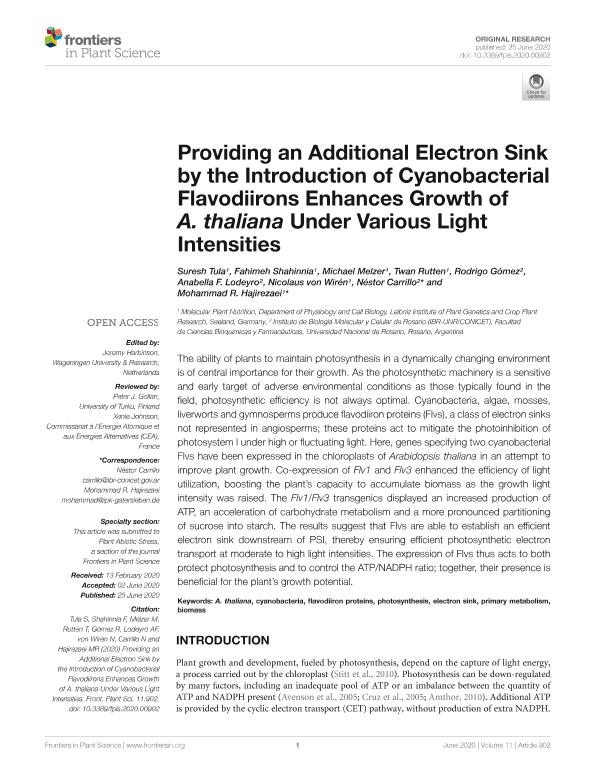Mostrar el registro sencillo del ítem
dc.contributor.author
Tula, Suresh
dc.contributor.author
Shahinnia, Fahimeh
dc.contributor.author
Melzer, Michael
dc.contributor.author
Rutten, Twan
dc.contributor.author
Gómez, Rodrigo
dc.contributor.author
Lodeyro, Anabella Fernanda

dc.contributor.author
von Wirén, Nicolaus
dc.contributor.author
Carrillo, Nestor Jose

dc.contributor.author
Hajirezaei, Mohammad R.
dc.date.available
2023-01-11T11:34:35Z
dc.date.issued
2020-06
dc.identifier.citation
Tula, Suresh; Shahinnia, Fahimeh; Melzer, Michael; Rutten, Twan; Gómez, Rodrigo; et al.; Providing an Additional Electron Sink by the Introduction of Cyanobacterial Flavodiirons Enhances Growth of A. thaliana Under Various Light Intensities; Frontiers Media; Frontiers in Plant Science; 11; 6-2020; 1-12
dc.identifier.issn
1664-462X
dc.identifier.uri
http://hdl.handle.net/11336/184254
dc.description.abstract
The ability of plants to maintain photosynthesis in a dynamically changing environment is of central importance for their growth. As the photosynthetic machinery is a sensitive and early target of adverse environmental conditions as those typically found in the field, photosynthetic efficiency is not always optimal. Cyanobacteria, algae, mosses, liverworts and gymnosperms produce flavodiiron proteins (Flvs), a class of electron sinks not represented in angiosperms; these proteins act to mitigate the photoinhibition of photosystem I under high or fluctuating light. Here, genes specifying two cyanobacterial Flvs have been expressed in the chloroplasts of Arabidopsis thaliana in an attempt to improve plant growth. Co-expression of Flv1 and Flv3 enhanced the efficiency of light utilization, boosting the plant’s capacity to accumulate biomass as the growth light intensity was raised. The Flv1/Flv3 transgenics displayed an increased production of ATP, an acceleration of carbohydrate metabolism and a more pronounced partitioning of sucrose into starch. The results suggest that Flvs are able to establish an efficient electron sink downstream of PSI, thereby ensuring efficient photosynthetic electron transport at moderate to high light intensities. The expression of Flvs thus acts to both protect photosynthesis and to control the ATP/NADPH ratio; together, their presence is beneficial for the plant’s growth potential.
dc.format
application/pdf
dc.language.iso
eng
dc.publisher
Frontiers Media

dc.rights
info:eu-repo/semantics/openAccess
dc.rights.uri
https://creativecommons.org/licenses/by-nc-sa/2.5/ar/
dc.subject
A. THALIANA
dc.subject
BIOMASS
dc.subject
CYANOBACTERIA
dc.subject
ELECTRON SINK
dc.subject
FLAVODIIRON PROTEINS
dc.subject
PHOTOSYNTHESIS
dc.subject
PRIMARY METABOLISM
dc.subject.classification
Bioquímica y Biología Molecular

dc.subject.classification
Ciencias Biológicas

dc.subject.classification
CIENCIAS NATURALES Y EXACTAS

dc.title
Providing an Additional Electron Sink by the Introduction of Cyanobacterial Flavodiirons Enhances Growth of A. thaliana Under Various Light Intensities
dc.type
info:eu-repo/semantics/article
dc.type
info:ar-repo/semantics/artículo
dc.type
info:eu-repo/semantics/publishedVersion
dc.date.updated
2021-09-15T15:14:41Z
dc.journal.volume
11
dc.journal.pagination
1-12
dc.journal.pais
Suiza

dc.description.fil
Fil: Tula, Suresh. Leibniz Institute of Plant Genetics and Crop Plant Research; Alemania
dc.description.fil
Fil: Shahinnia, Fahimeh. Leibniz Institute of Plant Genetics and Crop Plant Research; Alemania
dc.description.fil
Fil: Melzer, Michael. Leibniz Institute of Plant Genetics and Crop Plant Research; Alemania
dc.description.fil
Fil: Rutten, Twan. Leibniz Institute of Plant Genetics and Crop Plant Research; Alemania
dc.description.fil
Fil: Gómez, Rodrigo. Consejo Nacional de Investigaciones Científicas y Técnicas. Centro Científico Tecnológico Conicet - Rosario. Instituto de Biología Molecular y Celular de Rosario. Universidad Nacional de Rosario. Facultad de Ciencias Bioquímicas y Farmacéuticas. Instituto de Biología Molecular y Celular de Rosario; Argentina
dc.description.fil
Fil: Lodeyro, Anabella Fernanda. Consejo Nacional de Investigaciones Científicas y Técnicas. Centro Científico Tecnológico Conicet - Rosario. Instituto de Biología Molecular y Celular de Rosario. Universidad Nacional de Rosario. Facultad de Ciencias Bioquímicas y Farmacéuticas. Instituto de Biología Molecular y Celular de Rosario; Argentina
dc.description.fil
Fil: von Wirén, Nicolaus. Leibniz Institute of Plant Genetics and Crop Plant Research; Alemania
dc.description.fil
Fil: Carrillo, Nestor Jose. Consejo Nacional de Investigaciones Científicas y Técnicas. Centro Científico Tecnológico Conicet - Rosario. Instituto de Biología Molecular y Celular de Rosario. Universidad Nacional de Rosario. Facultad de Ciencias Bioquímicas y Farmacéuticas. Instituto de Biología Molecular y Celular de Rosario; Argentina
dc.description.fil
Fil: Hajirezaei, Mohammad R.. Leibniz Institute of Plant Genetics and Crop Plant Research; Alemania
dc.journal.title
Frontiers in Plant Science
dc.relation.alternativeid
info:eu-repo/semantics/altIdentifier/url/https://www.frontiersin.org/article/10.3389/fpls.2020.00902/full
dc.relation.alternativeid
info:eu-repo/semantics/altIdentifier/doi/http://dx.doi.org/10.3389/fpls.2020.00902
Archivos asociados
